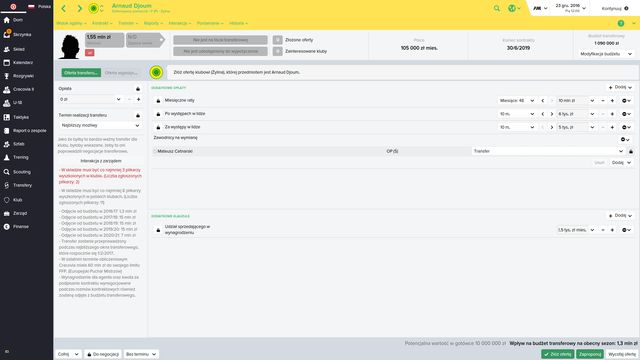Football Manager 2016: Buying a player

Stronger players most often already have a club, so the first element of the transfer negotiations is to make an offer to them. Only when the deal is made with the club, you can start negotiating the contract. To make an offer to the club, find a player that you want and select Transfer -> Make An Offer. You will open a negotiation window, in which you set the price and other financial gratifications, along with additional clauses. When choosing the Make An Offer option, you make an offer and you will receive an answer after a few days. The Make Enquiry option will result in receive an counteroffer right away, if of course the club wants to sell the player or if the price wasn't too low. By using this option, your negotiations go faster and you can make a few offers. At the end, select Make An Offer also.
Basic options
Fee - an amount of money that is immediately paid to the other club, after discussing the contract with the player. It is counted out from the transfer budget.
Transfer date - a window in which the transfer takes place. During the season, you can buy players during the winter break or summer holidays. You can also set a different transfer date (for example when you negotiate in autumn and want to buy the player after the season).
Negotiable/Non-negotiable - turning off the option of negotiating (the other club can accept or reject it), or some of its elements (for example non-negotiable fee). By using this option, you can make the other club accept a lower offer, but you risk that they will end the negotiations.
Decision deadline - the time during which the other club should respond to your offer.
Budget modification - if you don't have enough money, you can quickly modify the budget here.
Additional fees
Monthly installments - an amount of money that you will pay every month. Be careful with this option: it can make a the other club eager to sell the player, but you risk having to lower your budget during next years. In the end, the price of the player will come out as higher than if you would pay the whole cost at once. However, it is a way to go if you really want to buy a certain player but you don't have enough money now (the amount of money that is taken from you current budget is lower than if you would pay the whole cost now).
After league appearance - a sum that you will pay to the other club after a given amount of the player's appearances in league.
Per league appearance - a sum that you pay to the other club after the player plays a certain number of matches in a league.
After international appearances - a sum that you pay to the other club after the player appears in a certain number of international matches.
Minimum league goals - a sum that you pay after the player has scored a certain amount of goals in league matches.
After promotion - if you manage a team that is not top class, you can offer a sum that will be paid after your club advances to first league.
Players to exchange - you can try to lower the price by offering a player to exchange. The other club has to discuss the contract with your player.
Additional fees can help you alter the transfer budget if you don't have enough money to buy a player. Offering an extra fee after reaching certain conditions can make the other club lower the price. However, bare in mind that the total cost of the transfer will be higher when the player meets the conditions. A high number of players bought this way can drag you to a financial breakdown and block your transfer budget in the next years. Use this option wisely.
Additional clauses
Loan back length - after buying a player, you can loan him to the club from which you got him. This may take place if you for example don't have a place for him in the squad now, but you buy him for future purposes.
Percentage of profit from next sale - a percentage that is counted out from the profit during next transfer. If you for example buy a player for w 2M and sell him for 5M, the percentage will be counted out from 3M.
Percentage of next sale - a percentage that is counted out from the total price during next transfer (if we consider the example given above, you would pay a percentage from 5M).
Buy back price - the price for which the other club can buy the player back in the future, even if his market price raises.
Share in salary - you can try to negotiate a salary that the other club will also be paying to the player that you buy. It will lower the total price of the player, but clubs rarely agree to such an offer (you can try to do it when it comes to low value players).
Arrange friendly - when the transfer is done, a friendly match will be played between the two teams.
Continuing negotiations
When buying a player, above all, be patient. A major part of success lies in the amount of time devoted to preparing an offer. Never agree to the first counteroffer of the second club. Most often, the prices are absurd, especially when buying promising junior players. Carefully read the offer and mind the additional fees and how they're doing to influence your budget. You will pay the lowest total price if you pay the whole cost right away. However, if you don't have enough money, you can use monthly installments or additional clauses (for example, percentage from next sale is a great option if you don't plan to sale the player or if his value will go down). Several offers and counteroffers make successful negotiations. When starting with a low price, you can gradually go higher and buy the player as cheaply as possible.
You are not permitted to copy any image, text or info from this page. This site is not associated with and/or endorsed by the developers and the publishers. All logos and images are copyrighted by their respective owners.
Copyright © 2000 - 2025 Webedia Polska SA for gamepressure.com, unofficial game guides, walkthroughs, secrets, game tips, maps & strategies for top games.
